Something Wild
- Tags:
- Wildlife
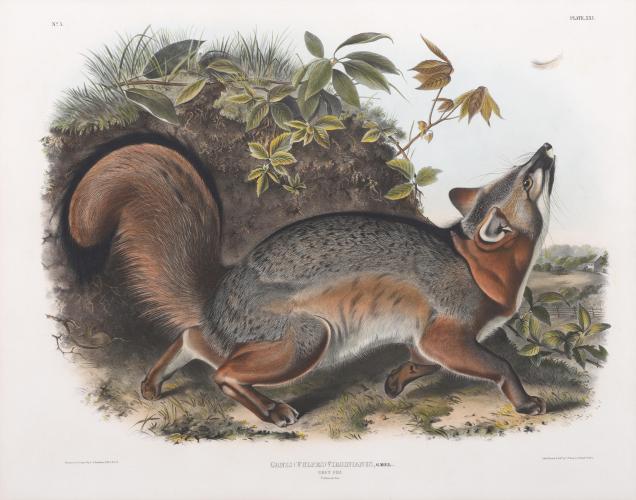
Gray fox - one of many NH species painted by John James Audubon. Courtesy NH Audubon
This week on Something Wild we further demonstrate that nature is everywhere…by going inside. We’re at the Currier Museum of Art looking at an exhibit of prints by John James Audubon from about 175 years ago.
Audubon was a man with well-known avian affections, but his was a broad world view and he was equally curious about four-legged wildlife across the continent. So towards the end of his own life he began an expedition to chronicle the "The Viviporous Quadrupeds of North America," aka mammals.
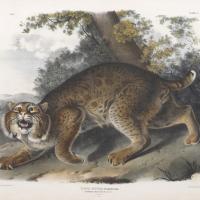
In 1843, just 40 years after Louis and Clark and the Corps of Discovery traveled from St. Louis to the Pacific northwest, Audubon tagged along with a party of fur-trappers into the great and wild west.
At the time, New Hampshire was at its agricultural maximum; around 80-percent of our forest had been cleared for the benefit of farmers and ranchers. Many of the animals that we think of as woodland creatures and central to the identity of the state were no longer living in New Hampshire or were struggling. On his trip, Audubon was finding these species and things out west that nobody on the east coast had ever seen.
The exhibit is called “From Birds to Beasts: Audubon’s Last Great Adventure” because during he died before he finished the 150 paintings he’d planned for the project. His sons John Woodhouse and Victor Audubon finished the work.
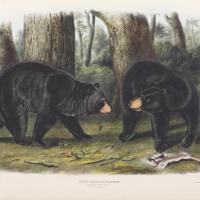
When you walk into the exhibit hall, you’re met by the man himself, looking right at you, in portrait. He’s affected a relaxed attitude flaunting a cambric shirt (standard attire for naturalists at the time!). And he’s holding what would have been the primary tools of his trade: a rifle, flint-lock and powder bag. Today, artists looking to study animals use a camera to shoot animals, using the photos or video as the basis for their artwork; but in Audubon’s day in order to study an animal for either biological or artistic purposes you had to collect a specimen. So Audubon would have had to hunt these animals or obtain them from hunters and trappers, so it’s fitting that he is depicted with a rifle.
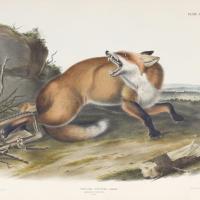
So it only made sense for him to coordinate his expedition with that of a trapping party heading to fort Union, one of the furthest western trading posts in the fur trade empire. And as the trappers harvested fur in a great howling wilderness, Audubon and his associates were harvesting images of a disappearing frontier. He brought his harvest back to easterners in urban areas.
As Andrew Spahr Director of Collections and Exhibition at the Currier explains, “if you’re an easterner in New York or Philadelphia and you open up your copy of The Viviporous Quadrupeds of North America and there’s a collared peckory or an armadillo and an arctic musk ox, they were almost unbelievable as images.

Though his images struck a chord with his audience, Audubon had his critics. Spahr says, that some were irked that Audubon ‘painted human emotions too freely onto nature.’ But that’s what made these images so engaging at the time and to us today is this suggestion of human emotion or human interaction.”
But his anthropomorphizing was more subtle than painting doe eyes on a western mule deer. His sympathetic treatment of some animals, and antagonistic, ferocious treatment of others makes you wonder about where was coming from when he decided how to portray these animals.
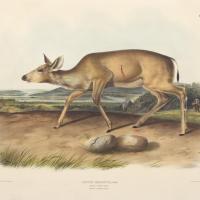
One print where this is present is a picture of two beavers gnawing on a tree. Beavers, or more specifically their pelts, were the coin of the realm for the American west. But by the 1840s the beaver was in serious decline; by the civil was they were eliminated from New Hampshire, which in 1905 prompted the state legislature (timely as ever) to passed a law protecting beavers in the state.
Audubon took some liberties choosing to accentuate the wood-cutting teeth. Was he simply drawing attention to a unique feature among north american mammals? Or was he subconsciously trying to ease the collective guilt of driving another species to near extinction by suggesting an aggressive temperament? You’ll have to make your own decision by checking out the pieces yourself now on exhibit through the end of August.
